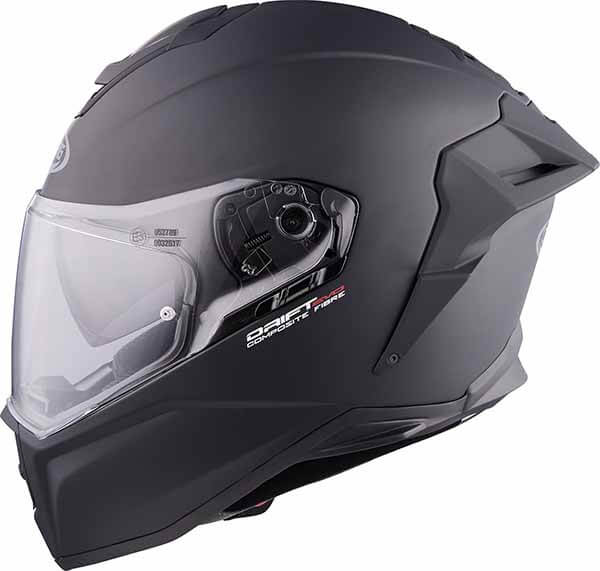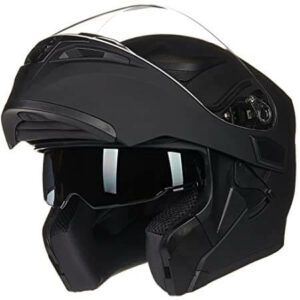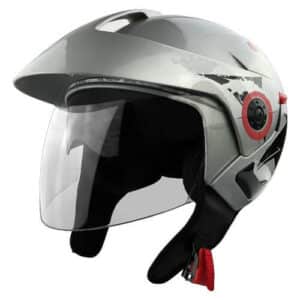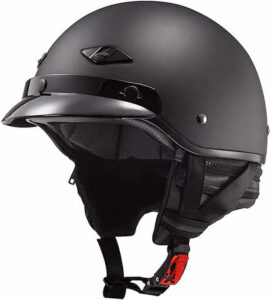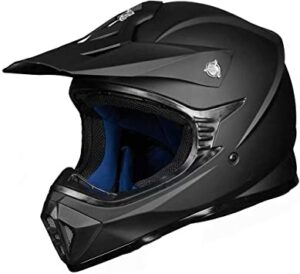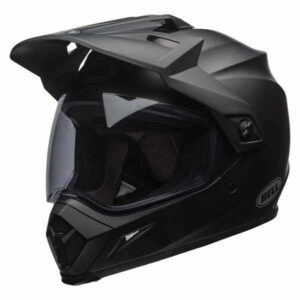When it comes to motorcycle helmet styles there are six main styles to choose from, each offering a different type of protection, so while some may look and feel better than others, they may be significantly less effective.
There are a few key factors that should be taken into account when choosing your next helmet, such as the motorcycle you ride, the roads and speeds you travel, and the predominant weather. Here’s a rundown of the six different types:
A Rundown of Motorcycle Helmet Styles
1. Full-Face Helmets
When it comes to helmet safety, the full-face varieties are heads and shoulders above the rest. The helmet covers the entire head and neck with a chin bar and visor. One of the major points of difference between a full-face helmet and many of the other styles of helmet on this list is the chin bar. There have been a number of studies that have shown that the chin and jaw sustain almost as much impact as the head in motorcycle accidents.
If safety is your first priority, then you won’t need to look any further than a full-face helmet. The good thing is the market for full-face helmets is heavily subscribed to by manufacturers, so it’s relatively easy to find something that fits your style and budget. Price relates largely to the materials used in the construction, with those made of carbon fiber and other composite materials generally at the upper end of the scale.
Check how the helmet fits before you buy, as the placement of the chin bar can vary slightly. The need for an effective ventilation system varies based on climate, but it can be the difference between whether or not your visor fogs up, so it’s always best to make sure the helmet is going to have sufficient airflow for your climate before you buy.
2. Modular Helmets
This style of helmet is a mix of full-face and open-face helmets. It is often referred to as a flip-up helmet because of the option to flip up the visor and chin bar and convert it from the equivalent of a full-face helmet to an open-face helmet.
While offering protection similar to that of a full-face helmet when worn with the chin bar and visor down, the pivot point has been shown to be a point of weakness, so if safety is your primary concern, then go with the rigid body of a full-face helmet. Weight can also be an issue with a modular helmet, with most weighing more than the full-face alternative.
Like full-face helmets, the price does vary significantly depending on the material they are constructed with and the features that they have, such as advanced ventilation systems or inbuilt Bluetooth communication.
3. Open-Face or Three-Quarter Helmets
Open face or three-quarter helmets are those that lack a chin bar or visor. This means you have the wind in your face so there’s no issue with ventilation. Unfortunately, the downside is the wind in your face comes with bugs and other foreign objects that without a visor or glasses you have no protection against. In fairness, there is the option of adding a visor to an open-faced helmet.
One off-putting factor about full-face or modular helmets is the weight, when wearing them for long periods that weight can cause neck pain. The advantage of the open-face helmet is the absence of the chin bar means there is a noticeable difference in the amount of weight your neck is supporting.
4. Half Helmets
Looking for protection for eyebrow level up, then these militaristic style helmets are what you’re after, although we wouldn’t recommend it. Some do offer limited protection to the back of the head or neck; however, none come with the option of adding a visor leaving the face and eyes exposed. For those that opt for this style of helmet, it’s recommended you also invest in a pair of googles or glasses to protect your eyes.
Despite their shortcomings, they are still a popular choice of helmet for those who like getting the wind in their face and they are approved by the relevant transport authority, something several motor safety foundations have objected to. In fairness, this style of helmet is generally most popular among those who ride on cruisers or similar and enjoy taking in their ride at a slower pace.
5. Off-Road Helmets
These helmets are designed with those who predominantly ride off-road in rocky or muddy terrain in mind. Off-road helmets generally have an elongated visor and chin bar area while the facial area is left partially open to allow better airflow, enabling the rider to breathe properly in what is likely to be a ride more strenuous than the average road ride.
While the visor does offer some protection against the mud and other elements, the partially open face area means that riders should look also wear goodies or glasses to protect their eyes.
They are available in a range of different materials including composite materials, such as fiberglass, Kevlar, and carbon fiber. These lightweight options are excellent in protecting neck fatigue after a long day of riding. In fact, most off-road helmets are noticeably lighter than their on-road counterparts and come with superior ventilation.
6. Dual Sport Helmets
Dual-sport helmets aim to cover both the off-road and on-road rider, mixing the features of a full-face helmet with the exterior look of an off-road helmet. The inside features of the helmet have additional cushioning and padding, giving it the comfort of a full-face helmet, while the elongated chin bar and visor that are a feature of off-road helmets are very evident.
The elongated chin bar can act to dampen the noise within the helmet, while the elongated visor and chin bar gives riders the option of riding with Google and glasses as well. This style of helmet is ideal for those that are covering mixed terrain, where they switch between on-road and off-road riding.
You may also like:
Snell vs DOT Motorcycle Safety Helmet Standard-Which is better?
14 Best Motorcycle Helmets Under 200 Dollars
Top 16 Lightest Motorcycle Helmets with Bluetooth 2021
The verdict
At the end of the day, it comes down to personal choice and the type of riding you do. While helmets can be heavy and annoying, and it is tempting to go with the most minimalistic and least restrictive, remember the safety features on these helmets can be minimalistic as well. The purpose of a helmet is to protect your head and neck in the event of an accident and given you only get one head, it’s always better to off on the side of safety.
Information for this article was partially sourced and researched from the following authoritative Government, educational, corporate, and nonprofit organizations:
Choose the Right Motorcycle Helmet
The United Nations Motorcycle Helmet Study
About the Author:
Michael Parrotte started his career in the motorcycle industry by importing AGV Helmets into the North American market. He was then appointed the Vice President of AGV Helmets America, total he worked with AGV Helmets for 25 years. In addition, he functioned as a consultant for KBC Helmets, Vemar Helmets, Suomy Helmets, Marushin Helmets, KYT Helmets, and Sparx Helmets.
In 1985, He is the Founder of AGV Sports Group, Inc. cooperation with AGV Helmets in Valenza Italy
Click here for LinkedIn Profile: https://www.linkedin.com/in/parrotte/
Click here for complete AGV Helmet & AGVSPORT History https://agvsport.com/michael-parrotte
Click here for all AGV Sports Group Social Media information http://agvsport.info/
FM/L



